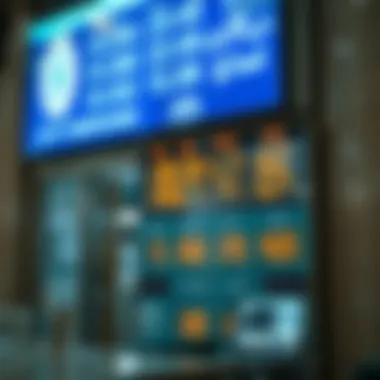Fifty Thousand USD to AED: Currency Conversion Insights


Intro
Understanding how currencies convert is essential for any individual or investor planning to move or invest in a different country’s economy. The spotlight here is on converting fifty thousand US dollars to United Arab Emirates dirhams, a crucial step for those engaging with Dubai’s dynamic market. The economic landscape in Dubai is not just thriving; it’s an intricate web of factors influencing exchange rates and investment opportunities.
Knowing the nitty-gritty of currency conversion ensures that investors, expatriates, and financial analysts can make informed decisions. It requires a careful eye on market trends, historical context, and the unique attributes of the UAE economy. As we delve into the specifics, the reader will find outlined key considerations, potential investment opportunities, and practical advice for navigating the currency exchange landscape in Dubai.
Market Trends
Observing the current market trends provides insights that are vital for anyone looking to convert a considerable amount of money like fifty thousand dollars. Understanding the fluctuations in currency rates can offer a clearer picture of potential costs and investments.
Current Property Prices
In recent years, property prices in the UAE have experienced considerable shifts, with certain areas becoming hot spots for investment. Popular districts such as Dubai Marina and Downtown Dubai have shown notable price increases, making them attractive to expatriates and investors alike. As of recent data, the average prices for a one-bedroom apartment in these areas hover around AED 1.1 million, which translates to approximately 299,000 USD.
Future Forecasts
Looking ahead, analysts predict that the trends in property prices will stabilize, but not without further fluctuations. Factors such as governmental policies, visa reforms, and global economic indicators are all expected to play roles in shaping these forecasts. Notably, with planned developments for the Expo 2020 site, the anticipation is that sectors like real estate will continue to flourish.
"Understanding market trends not only helps in the immediate currency conversion but also lays the groundwork for future investments."
Investment Opportunities
When contemplating converting fifty thousand USD into AED, it’s equally important to assess potential investment opportunities. There are several high-return areas within Dubai as well as diverse financing options for investors.
High-ROI Areas
Research indicates that districts such as Dubai Silicon Oasis and Dubai Sports City offer favorable conditions for investment. These areas have relatively lower initial investment costs while presenting significant growth potential, especially as developers continue to pour resources into infrastructure and community enhancement.
Financing Options
Investors often explore different financing routes to maximize their purchasing power. Banks in the UAE commonly offer competitive mortgage rates, with some institutions providing loans up to 80% of the property value. However, it's imperative to engage with a financial adviser who can provide tailored solutions that align with individual investment goals.
For those interested in further reading, resources like ae.mof.gov.ae can offer insights into regulatory frameworks, while numbeo.com provides up-to-date cost of living indices which can inform investment decisions.
In summary, comprehensively understanding both the implications of current market trends and the available investment opportunities provides a solid foundation for anyone considering converting their USD into AED. It's not just about the today; it's about what tomorrow can hold in a bustling metropolis like Dubai.
Exchange Rate Dynamics
In the ever-evolving financial landscape, grasping the concept of exchange rate dynamics is crucial when navigating currency conversion, notably when converting American dollars to Emirati dirhams. Understanding exchange rates helps individuals and businesses make informed financial decisions, ensuring they get the best value when exchanging currency. The nuances of currency values, influenced by various factors and historical trends, play a pivotal role in determining how much one currency is worth compared to another.
Understanding Currency Values
To break it down simply, currency values fluctuate based on supply and demand—what people are willing to pay and what sellers are ready to accept. This creates a perpetual ebb and flow in exchange rates that can catch even seasoned investors off guard. Take for instance the USD to AED exchange rate: these fluctuations can significantly impact financial transactions, investments, and expatriate living costs in the UAE. Grasping these fundamentals not only aids in budgeting but also in strategic planning for investments and financial negotiations.
Factors Influencing USD to AED Conversion Rates
Supply and demand
Understanding the supply and demand dynamics is vital when diving into currency conversion. When there is high demand for USD in the UAE, the value against the AED may rise, meaning you’ll get fewer dirhams per dollar. Conversely, if there’s more dirhams available compared to dollars, the conversion rate may dip. This intrinsic quality of the marketplace ensures that exchange rates remain fluid, responding to global economic events or changes in consumer behavior. A key characteristic here is how market sentiment can shift swiftly based on news or economic indicators, amplifying or dampening currency values.
Geopolitical factors
Political stability and geopolitical relationships play a major role in currency valuation. For example, the United States' trade agreements, sanctions, or foreign policy decisions can directly affect investors’ confidence in the dollar, subsequently influencing the USD to AED conversion rate. Geopolitical factors create ripples that can either stabilize or cause turmoil in currency markets. The ability to understand these elements not only aids in comprehending immediate impacts on conversions but also assists investors in thinking long-term—navigating complex waters of global markets becomes essential.
Inflation concerns
Finally, let’s hone in on inflation concerns. Inflation affects purchasing power, which inevitably ties back into currency values. High inflation in the U.S. can lead to decreased confidence in the dollar, pushing its value down against the AED. A critical aspect to understand here is how inflation can erode savings and investments over time, making it less appealing to hold assets as currency depreciates. Therefore, being mindful of inflation trends—both in the U.S. and the UAE—can provide valuable insights into projected shifts in the USD to AED conversion rate.
Historical Trends in USD to AED Conversion
When diving into historical trends, one can observe how the USD/AED conversion rate has reacted to global events over the years. Past crises, economic booms, and even sporting events can create notable shifts. By analyzing these trends, investors can formulate more educated predictions and strategies. Tools like charts and historical data can serve as helpful resources for both seasoned professionals and newcomers alike. They can be found on financial news sites, economic forums, and databases such as Bloomberg or TradingView.
Conversion Methods


Understanding the various methods for currency conversion can significantly impact one’s financial decisions, especially when dealing with larger sums like fifty thousand US dollars. The approach chosen may affect the rate at which currency is exchanged, the fees that apply, and ultimately, the amount received in dirhams. Here, we break down three main avenues for currency exchange: direct currency exchangers, online platforms, and bank services. Each method has its own advantages and considerations that users should weigh carefully.
Direct Currency Exchangers
Direct currency exchangers, often found in busy urban areas or popular tourist spots, offer a tangible way to convert currency. These establishments can be independent shops or parts of larger chains. The key attraction of direct exchangers is the immediacy—they allow people to convert cash on the spot, which can be quite convenient.
However, there are critical aspects to keep in mind.
- Exchange Rates: The rates at direct currency exchangers can vary significantly from the market rates. Sometimes you may find a deal, but often these places charge a markup that isn't always transparent.
- Safety Considerations: Carrying large amounts of cash poses risks. Patrons need to be cautious to avoid pickpockets or getting short-changed.
- Limited Availability: Outside of major cities, finding a reliable exchanger can be a hassle.
So while the instant benefit of cash in hand may seem appealing, it’s wise to research ahead and ensure you're getting a good deal without the pitfalls.
Online Currency Conversion Platforms
With the advent of technology, online currency conversion platforms have emerged as an efficient alternative. Websites and mobile apps provide a wealth of information at your fingertips. Users can find current exchange rates, compare different providers, and make transactions from the comfort of their homes.
Some benefits include:
- Rate Transparency: Many online platforms showcase real-time exchange rates, allowing users to track fluctuations and select the optimal time for their transaction.
- Reduced Fees: Online exchanges often feature lower transaction fees compared to physical currency exchangers. This can lead to notable savings on larger exchanges like fifty thousand USD.
- Convenience: Transactions can be done at any time, eliminating the need to physically visit a location.
Nevertheless, there are downsides to consider:
- Security Risks: Users must ensure they are using reputable platforms to avoid scams or data breaches.
- Processing Times: Unlike cash exchanges which are immediate, online transactions may take longer to process, and users may find themselves waiting for funds to be available.
Bank Services for Currency Exchange
Banks have long been trusted institutions for currency exchange. They provide a reliable and often secure way to convert money from USD to AED. This option is particularly favored by those who prioritize safety over convenience.
Considerations include:
- Better Rates for Accounts Holders: Many banks offer favorable exchange rates to their account holders. If you have an existing relationship with a bank, it may be worth consulting to see what rates they can provide.
- High Security: Banks are usually well-regulated, thus offering peace of mind when dealing with larger amounts.
- Fees: Banks may charge fees that can vary widely, so it's essential to check these in advance. Some may have lower upfront costs but offset them with hidden transaction fees.
Conversely, the drawbacks of bank exchanges can include:
- Limited Availability of Services: Not all banks provide currency exchange, or they may limit the types of currencies they handle.
- Longer Waiting Times: Much like online platforms, the time taken for cash to be converted might stretch longer than expected, especially if you're not withdrawing directly from your bank account but are trying to convert cash.
"Choosing the right method for currency conversion requires weighing the pros and cons of each option based on personal preferences and needs."
In summary, evaluating conversion methods is critical for anyone looking to convert fifty thousand USD to AED. Whether choosing direct currency exchangers, online platforms, or bank services, being well-informed can lead to sharper financial decisions.
Calculating the Conversion
Understanding how to calculate currency conversion is crucial for anyone looking to make sound financial decisions. When dealing with significant amounts like fifty thousand US dollars, accuracy and efficiency are non-negotiable. Conversion calculations often affect budgeting, investment plans, and overall financial strategy, especially for expatriates and investors in the UAE. This section breaks down the intricate details of assessing exchange rates and processing conversions.
Current Exchange Rate Overview
The current exchange rate is the heartbeat of currency conversion. It determines how much of one currency you can obtain with another. As of this writing, the USD to AED exchange rate fluctuates due to various economic factors.
- Live Market Rates: Investors can check platforms like XE.com or OANDA for real-time rates. These rates reflect what’s happening in the market as they account for global economic shifts.
- Average Rates: By studying average rates over a period, one can gauge stability or volatility, which helps in planning conversions or investments.
- Rate Variability: Remember that exchange rates change frequently. Factors such as economic news, political events, or even trade agreements influence these rates heavily.
Staying informed about the current exchange rate helps investors make wise decisions about when to convert. This is especially vital for managing timing in large transactions involving significant amounts of currency.
Example Calculation for Fifty Thousand USD
Let’s say, for instance, the current rate stands at 3.67 AED for every 1 USD. Here’s how we would calculate how many dirhams you would receive for fifty thousand US dollars:
Calculation Process:
- Exchange Rate: 1 USD = 3.67 AED
- Amount in USD: 50,000 USD
- Calculation:
Thus, by converting fifty thousand US dollars at the current rate, an expatriate would receive 183,500 AED. This conversion illustrates a practical example, showcasing how straightforward the calculation can be once the current exchange rate is known.
The calculation relies heavily on the exchange rate at the moment of conversion; thus, attention to market trends will bring advantages in timing the transaction.
Understanding Transaction Fees


When it comes to currency conversion, focusing solely on the exchange rate can be a misstep. Transaction fees can add up quickly, eroding the expected financial benefits from converting currencies. Here’s what to be aware of:
- Types of Fees: Banks and currency exchanges may apply different fees such as flat fees per transaction or percentage-based fees on the total amount. Assure to clarify what fees apply ahead of conversion.
- Hidden Fees: Some establishments may not disclose their fees upfront, so always ask for a complete breakdown of costs. Otherwise, you could walk away with less than anticipated.
- Comparing Options: Different service providers have varying fee structures. It's wise to shop around. For instance, a local bank, an online currency conversion service, or even an airport exchange might each have significantly different fees.
Overall, understanding transaction fees will give a well-rounded view of costs and help gauge the true value obtained from the conversion process.
Implications for Expatriates
Understanding the implications of currency conversion is crucial for expatriates moving to the United Arab Emirates. Expat living often entails a unique set of financial challenges, and being conversant with currency issues is an essential part of navigating these waters. This section dissects the importance of currency conversion, especially when it comes to budgeting and investments.
Budgeting for Living Expenses in AED
When relocating, one of the first tasks is budgeting for living expenses. Knowing how much fifty thousand US dollars translates into UAE dirhams is key. It affects everything from housing to groceries. If one is financially literate, it can save you quite a bit of worry down the road. Rent in places like Dubai can be sky-high, and understanding the currency rate allows expatriates to anticipate what percentage of their income will go towards housing.
Another element is understanding daily living costs. Basic expenses such as food, transportation, and utilities must also line up with the AED equivalent. Correct budgeting means you'll not only cover your needs, but have some leeway for emergencies or leisure activities. This can mean the difference between a comfortable stay and scraping the barrel every month.
Investment Opportunities in Dubai
Expatriates often look for ways to invest their money wisely. Dubai presents a myriad of investment opportunities. From real estate to local businesses, the options are vast.
Real Estate Investments
Real estate in Dubai can represent a golden ticket for many expatriates. With its towering skyscrapers and rapidly growing economy, investing in property can lead to profitable returns. The vacation rental market, in particular, has seen a boom, attracting tourists throughout the year. This aspect makes it a solid bet.
A key characteristic of real estate investments in Dubai is the possibility of high rental yields. The unique feature of Dubai’s property market is the lack of property tax, which is a draw for many global investors. This can significantly impact the overall return on investment, providing a substantial edge compared to other cities.
However, like any investment, it comes with its challenges. Market fluctuations can be a downside, so one should remain vigilant. It's wise to do thorough research before making a move.
Local Businesses
Investing in local businesses also offers expatriates a chance to tap into the UAE's growing economy. With a growing consumer base, small businesses can thrive, provided they address local needs and preferences. This is particularly important in a multicultural city like Dubai where diversity influences market behaviors.
A key characteristic here is the potential for establishing long-term partnerships. The unique feature of becoming integrated into the local community creates a network of relationships that can aid business growth. However, understanding the local regulations can be a hurdle. It can require considerable effort to stay compliant, yet the rewards can bring their own satisfaction.
Understanding Economic Policies in the UAE
Familiarizing oneself with the economic policies in the UAE is crucial. These regulations impact both expatriates and their investments. Unlike many countries, the UAE has relatively low taxes, which can be beneficial for those who wish to save more. Additionally, government initiatives aimed at boosting certain sectors can offer investment insights for expatriates.
In sum, being well-informed about currency conversion and economic frameworks in the UAE can lead to a richer expatriate experience, whether in managing living expenses or engaging in investments.
The Role of the Dirham in Global Trade
The UAE dirham holds a critical position in the global trading landscape, not merely as a representation of currency but as a symbol of the nation's economic strength and versatility. The dirham's integration into international markets reflects the ambitions of the UAE to be a global player, enhancing its market visibility and attractiveness to investors. This section delves into the various dimensions of the dirham's significance, focusing on specific elements such as economic positioning and its fixed exchange rate system.
UAE's Economic Position
The incredible growth of the UAE's economy, particularly in sectors like tourism, finance, and real estate, has positioned it as a central hub in the Middle East. This transformation has made the UAE one of the most prosperous countries in the region, leveraging its strategic geographic location to facilitate trade between Europe, Asia, and Africa.
Significant investments in infrastructure, coupled with a diversifying economy, have drawn in foreign investments like bees to honey. In 2022 alone, the UAE attracted approximately $20 billion in foreign direct investment. The cornucopia of opportunities stems from favorable business conditions and a stable regulatory environment, making it prime ground for expatriates and potential investors alike.
Dirham's Peg to the Dollar
Stability advantages
A unique characteristic of the UAE dirham is its peg to the US dollar at a rate of approximately 3.67 AED to 1 USD. This stability provides a solid floor for investors and businesses, allowing them to plan financials without excessive concern for fluctuation. This exchange rate system simplifies international transactions, providing both buyers and sellers the confidence to conduct their business dealings smoothly.
The pegging mechanism eliminates excessive volatility, which can often be detrimental in currency markets. For instance, during economic upheavals in global markets, the dirham’s stability ensures that expatriates and businesses do not face crippling losses. The consistent rate offers predictability in remittances and business costs, adding a layer of safety for those involved in trade or investment.
"The dirham's fixed exchange rate acts as a buffer during times of economic uncertainty, making the UAE an appealing destination for financial activities."
Potential drawbacks
While the dirham’s peg to the dollar has its advantages, it also brings along some potential drawbacks. One of the key downsides to this stability is the limited flexibility in monetary policy. When the US Federal Reserve adjusts interest rates, the UAE is compelled to follow suit, which can occasionally lead to undesirable economic conditions domestically.
For instance, if the Fed raises rates to combat inflation, the subsequent increase in the UAE’s interest rates may stifle local economic growth. This can create a scenario where the domestic market isn’t as responsive to cater to the needs of the local economy and can highjack affordability for consumers and businesses.


Additionally, being tied to the dollar means that external pressures can directly affect the dirham's value. For instance, if the dollar weakens due to global events or policies, the dirham can also face depreciation risks, which can be concerning for investors focused on sustainability
This interplay of stability and drawback makes the situation complex. Ultimately, while the austere measures provide a rock-solid foundation for transactions, they also necessitate a keen awareness of global market trends and forecasts by investors and expatriates.
In sum, the role of the dirham in global trade is multi-faceted. It embodies resilience in a fluctuating economic landscape while demanding that stakeholders remain vigilant about its interconnectedness with the dollar and overall economic policies. Understanding these dynamics is crucial for anyone engaging in currency conversion or investment within the UAE.
Future Trends in Currency Exchange
As we look ahead into the realm of currency exchange, particularly regarding the conversion rates between the US dollar (USD) and the United Arab Emirates dirham (AED), understanding future trends becomes paramount. This section shines a light on forthcoming movements and the factors driving these changes in an increasingly interconnected global economy.
Considering historical data alongside current economic climates, investors and expatriates alike can better strategize their financial decisions. Knowing what to expect allows individuals to guard against sudden fluctuations and capitalize on favorable rates when they arise. With changes in trade policies, central bank strategies, and geopolitical tensions, these elements all play a key role in shaping the landscape of currency exchange for years to come.
Predicted Movements in the USD to AED Rate
Forecasting currency movements requires a blend of analytical skills and market awareness. The USD to AED rate has historically maintained a relatively stable peg, but several variables can cause its fluctuations. Analysts often keep a close eye on both technical indicators, such as moving averages, and fundamental factors that could sway the market.
- Economic Performance: The future trajectory of the USD will largely depend on economic growth in the United States and overall demand for the dollar. With expanding industries and robust job markets, the dollar’s value may experience a bullish trend.
- UAE Economic Recovery: On the flip side, the health of the UAE economy after the global pandemic will influence the dirham's strength. A thriving tourism sector, increased foreign investments, and successful expo-driven growth could enhance its value, impacting exchange rates.
- Interest Rates: Central banks’ interest rate policies often steer currency values. If the Federal Reserve raises rates to combat inflation, the USD could appreciate, leading to altered rates against the dirham.
Ultimately, close monitoring of economic indicators is crucial for anyone involved in cross-border transactions or investments as these movements materialize.
Impact of Global Events on Currency Values
When discussing currency values, it's essential to acknowledge the often unpredictable nature of global events. Shifts on the world stage can impact currency exchange rates in ways that may not be immediately evident.
- Geopolitical Instability: Events such as political unrest, trade wars, or international sanctions can trigger significant volatility. For instance, tensions in oil-producing regions could suddenly elevate the dollar due to its safe-haven status, while the dirham may experience fluctuations based on regional stability.
- Global Economic Shifts: Economic policies or crises in major economies also ripple through currency markets. For example, if a significant financial issue arises in Europe or Asia, it can lead to a surge in buyers seeking safety in the USD, altering its value against the AED.
- Pandemic Effects: Global health crises, as clearly demonstrated during the COVID-19 pandemic, can lead to rapid changes in currency values based on shifts in trade patterns, investment sentiments, and tourism impacts.
In summary, staying attuned to these significant, often unforeseen factors is essential for navigating future currency conversions. Being informed means being prepared, allowing for more accurate forecasting and risk management in financial strategies.
Common Misconceptions About Currency Conversion
Currency conversion can often be shrouded in misunderstandings and confusion. Recognizing the frailties in popular beliefs about currency exchange is essential for anyone navigating international finance, especially when dealing with significant amounts like fifty thousand US dollars. These misconceptions can distort one's perception, leading to poor financial decisions that are costly in the long run. It’s vital to keep an eye on the accuracy of information and to discern the facts from fantasy in this complex arena.
Beliefs vs. Reality in Currency Exchange
There are several prevailing misconceptions surrounding currency exchange that can skew understanding and approach. For instance, many citizens operate under the misguided notion that all currency exchange outlets offer the same rates. In truth, exchange rates can differ significantly among banks, currency exchange booths, and online platforms.
- The uniformity of rates: One might believe that visiting a local foreign exchange shop guarantees the best rate, yet each establishment sets their prices based on individual operating costs and profit margins. This means the rates can vary, prompting a need for diligence.
- Market fluctuations: Some people assume that currency values remain static over short time frames and hence do not check rates regularly. However, the reality is that exchange rates fluctuate continually, influenced by myriad factors such as economic indicators and geopolitical events.
Underestimating the importance of checking various platforms can lead to a disappointing realization that one could have gotten a better deal elsewhere. As currency isn’t a commodity one exchanges every day, failing to educate oneself on market patterns can translate into substantial losses.
"Knowledge is the most valuable currency in this game, and paying attention can save you a pretty penny."
The Complexity of Currency Values
Currency values are anything but simple, defying straightforward categorization. The distinction between perception and reality can lead to costly errors. Here are important points to consider:
- Influence of supply and demand: Currency value mirrors the basic principles of supply and demand; when more people want a currency, its value increases. Yet, this is often overlooked in casual conversations about currency.
- Economic indicators: Various economic reports such as GDP and unemployment figures can affect currency strength but are frequently ignored by the average person who may rely solely on anecdotal evidence or favorable biases about one currency over another.
- Global interdependencies: The interconnectedness of global economies today complicates currency value. Political events, global crises, or other factors can ripple through different currencies, altering values in unexpected ways.
Investors and expatriates, when comprehending currency conversion, must dig beyond surface beliefs. They should account for the numerous elements in play. An overall understanding of these complexities will provide a clearer perspective, leading to informed and strategic financial decisions.
In the world of currency conversion, it’s important to sift fact from fiction and appreciate the mosaic of influences determining how much fifty thousand US dollars translates into dirhams.
Ending
In wrapping up our exploration of converting fifty thousand US dollars to UAE dirhams, it becomes evident that understanding this topic goes beyond mere numbers. It encapsulates various nuances that can significantly influence financial decisions for expatriates, investors, and anyone engaging in currency exchange transactions. Given the fluctuating nature of exchange rates, grasping the underlying mechanics is pivotal. The intricate dance of supply and demand, geopolitical developments, and inflation trends all play a role in shaping those rates.
Summary of Key Insights
Diving into the conversion landscape, several key insights surface:
- Dynamic Rates: The USD to AED conversion isn't static; it's a moving target influenced by many factors. Staying updated on exchange rates is crucial for making informed financial decisions.
- Direct Conversion Options: Different pathways exist for completing your currency conversion. Whether opting for bank services or engaging with online platforms, understanding the costs involved can save you a pretty penny.
- Impacts Beyond Numbers: The implications of conversion extend into everyday life, influencing budgeting strategies and investment opportunities, especially in a city as dynamic as Dubai.
As expatriates prepare to transition their finances or investors eye potential gains, these insights equip them with knowledge to navigate this complex arena smoothly. The merging of practical tips with in-depth analysis serves to demystify the currency conversion process, allowing for better strategic planning.
Considerations for Future Transactions
Looking ahead, a few considerations can enhance future currency transactions:
- Market Monitoring: Investors should continuously monitor exchange rates and market conditions. A proactive approach can yield better conversion rates.
- Understanding Fees: Each platform or bank may impose different fees for their services. Transparent knowledge of these can help avoid unnecessary expenses.
- Long-Term Perspectives: For those planning to live or invest in the UAE long-term, considering hedging strategies or fixed-rate options may provide additional financial security.
As always, keeping an eye on global economic trends will aid in forecasting the health of the USD versus AED exchange rate. In this ever-evolving financial landscape, staying informed is not just beneficial; it’s critical.



